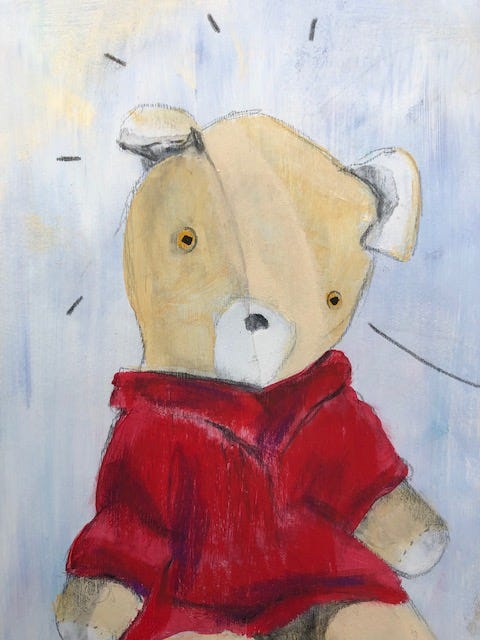
Dear Reader,
January
At the start of the year my parents had tasked their local plumber to replace some copper piping in the airing cupboard.
Their airing cupboard is quite something. For one thing, it’s much larger than a cupboard thanks to its previous life as a bathroom before the house was extended in the 1980s. Its avocado bathroom suite now thankfully a distant memory, the airing cupboard boasts floor-to-ceiling slatted shelving, the hot water cylinder and associated pipework, and a whole load of bath towels, bedclothes, blankets, dust sheets, hot water bottles and hankies. A washing line stretches from one end of the space to the other, not to dry clothes but to air them once they’ve been steam-ironed, so they don’t get put away sweaty.
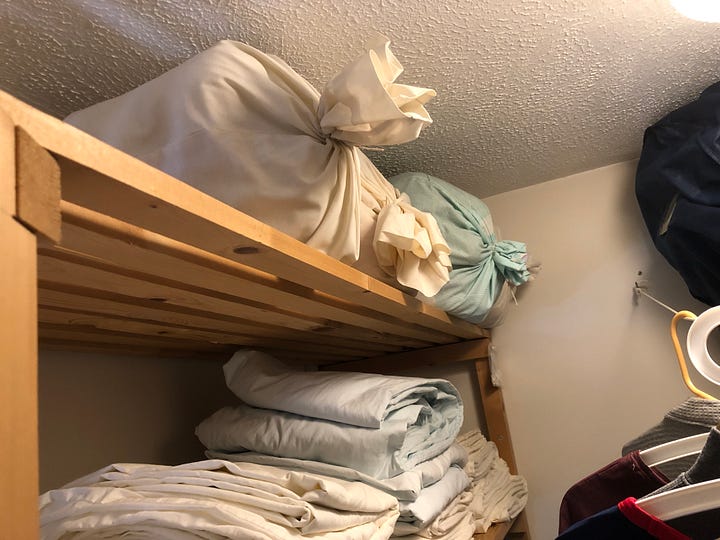
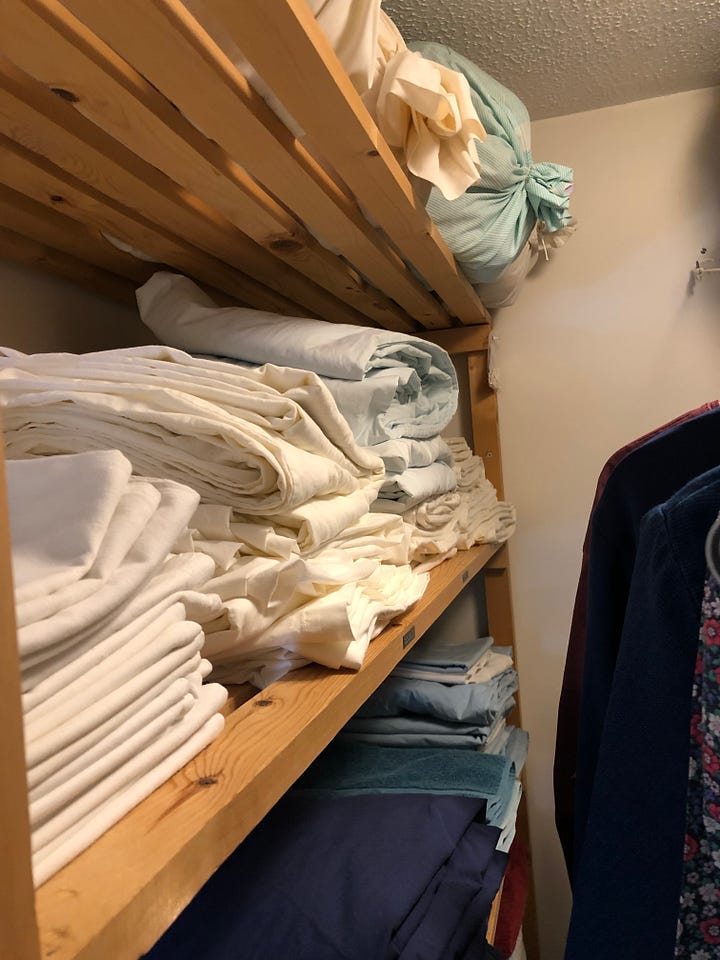
And because of the plumber’s impending visit, all of this stuff needed taking out. We formed a line, Mum, Dad and I, carefully passing along stacks of towels and sheets.
‘We’re going to need to do something with those’, said Mum.
She tilted her head up towards the ceiling, then looked across to me. Two teddy bears were looking down at us. Behind them was a load of knobbly pillowcases, tied up with string at the top to make bags.
‘And it’s not just those two. All of those pillowcases are full of bears.’
I sighed. ‘Come on, then.’ We passed everything on the top shelf to Dad, who put them alongside everything else in the spare room1, the temporary billet for all the sheets, towels and perished hotties.
The two bears not in bags, Teddy Edward and Poley, leaned up against the bank of tied-up pillowcases containing their comrades.
I’d known that they were there, safe and sound in the airing cupboard, but I hadn’t really thought about these old friends for years, even decades. We hadn’t kept them for any other reason than to just still have them: they were never going to be passed to the non-existent next generation; they were just our bears. Old friends.
‘We can’t throw them away!’ I’m not sure whether I was cross, upset or both. Reader, this 48-year-old small child was struggling with the situation.
Mum passed me a very dusty Teddy Edward and held on to Poley, who was the grubbiest, greyest representation of a polar bear I’d ever seen.
‘Shall we give these two a wash?’
I began to feel better. I peeled Teddy Edward’s moth-eaten red jumper off him, and, judging it to be more hole than hale, threw it straight into the bin. Each bear was duly zipped into its own net laundry bag and popped into the washing machine, and then later, the dryer.
Intermission, with the following treats available from the concession stand:
A round of coffee
Some calming down
A ride in the washing machine
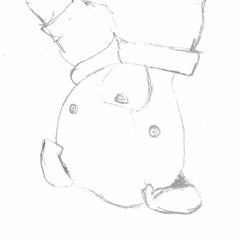
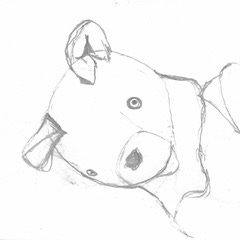
Without their decades-thick layer of dust, the two bears were both two shades lighter when we unzipped them. Poley was almost gleaming.
Teddy Edward’s laundry bag wasn’t empty, though. I tipped a pile of coloured crumbs out onto the table.
It was stuffing. Some of his insides were on the outside.
This threadbare childhood friend was leaking. Fabric had become so thin where his limbs met his torso that tiny holes had appeared and joined up into bigger ones: my tired old bear had become a shaker for scattering his own disintegrating sponge stuffing.
‘How about we have him looked at?’ Mum asked. ‘Repaired?’
I shook my head. ‘Too holey. Too broken.’ I couldn’t believe how hard I was finding this.
The next week I visited again, this time to clean the empty airing cupboard now that the plumber had been. Afterwards, the three of us operated our bucket line in reverse, filling the shelves from bottom to top with the newly-edited and curated collection of household textiles.
The tied-up bulging bags of bears were stashed unopened on the shelf they’d always occupied. ‘Another day’, said Mum.
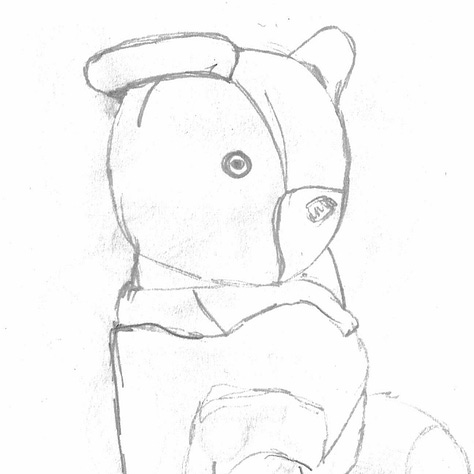
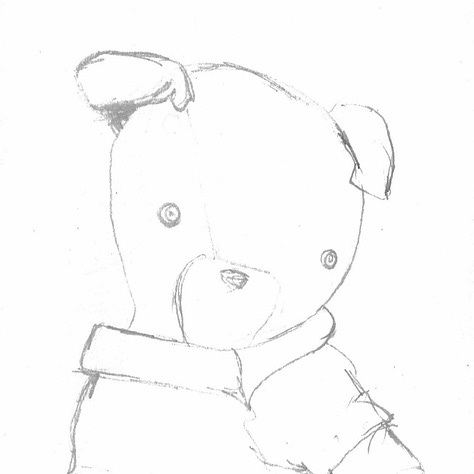
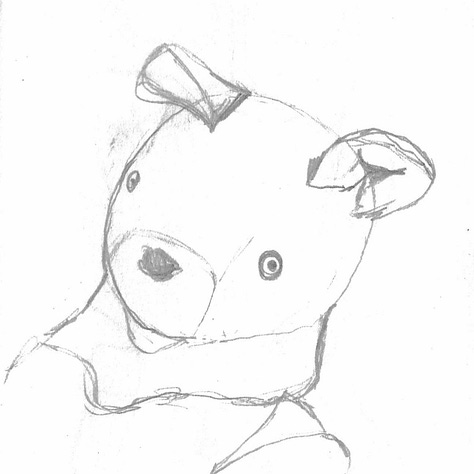
February
‘I’ve got something to show you’, Mum announced when I was over for a visit last month. ‘Someone, in fact.’
Sitting up on a chair was Teddy Edward, looking unusually chipper.
‘Look!’ Mum passed him to me.
Not only did Teddy Edward look different, he felt different, too. His arms and legs held themselves out firmly. His tummy didn’t sag, and his bottom was rounder. Hang on, had he put on weight? Before he hadn’t ever had a mouth, but now he was almost smiling.
‘However did you do it?’ I asked. ‘You’ve done an amazing job!’
Mum laughed. ‘Not me! No, we took him to the Repair Café!’
The Repair Café Foundation is a non-profit organisation set up by Martine Postma, who set up the first site in Amsterdam in 2009. Since then the network has become a worldwide movement, with an estimated 39,750 volunteers working on an estimated total of 47,700 repairs in around 2,650 Repair Cafés every month.
Here’s their goal:
Repair Café International Foundation wants to make repair a part of the local community once again. It aims to maintain and spread repair expertise, and to promote social cohesion by bringing together neighbours from all walks of life and sets of motivations in the form of inspiring and accessible meetings.
Mum explained the process that she and Teddy Edward had gone through at Chailey Repair Café, which welcomes visitors to its sessions in the church once a month. She’d joined the queue in the church porch, filled in a numbered form and signed the all-important disclaimer on the back.
It was like a consent form for surgery.
She’d handed her form to Rachel2, the volunteer at the check-in desk, and settled down at one of the café tables to enjoy a cuppa while she waited for her assigned repairer to fetch her when her number came up.
Volunteer Jane fetched Mum and Teddy Edward, leading the way to her repair station: a table in the section of the church labelled ‘Fabric Repairs’. Three other ladies already had needles and thread on the go, and all were mending soft toys, including an elephant with a floppy trunk.
There was an old Harrod’s bear sitting in front of Jane’s chair. ‘Don’t mind him!’ she said. ‘He’s here to be collected. I had to do a home repair on him – he was a big job.’
Jane asked Mum the name of her repair subject. ‘Teddy Edward’, she said.
‘Oh, I’ve got a Teddy Edward!’ said Jane.
Reader, Mum knew right then that this was going to be fine.
Having sorted out the salt-shaker holes, Jane carefully unpicked a seam and filled out Teddy Edward with some new nylon wadding. ‘We have to be careful with old, degraded foam’, she explained. ‘It’s nasty to breathe in. Removing degraded foam is definitely a job for the summer, outside in the garden.’
She stitched the unpicked seam back up, and had a good look at Teddy Edward’s face. ‘Now, what about a smile?’ She picked up her needle and threaded it with black embroidery silk.
March
Reader, I had to experience the Repair Café for myself. For a moment I kicked myself for throwing away our broken stick blender last week, but then remembered why it had bitten the dust: its blending wand was plastic, not metal, and the dregs of a recent batch of my normally deliciously smooth homemade soup at the bottom of my lunch flask had contained little flakes of plastic. Not even the experts at the Repair Café would have been able to take on that job successfully.
But given that I was keen to meet Jane, the fellow Teddy Edward owner who’d fixed my Teddy Edward, I had a look at who else might need some attention with needle and thread.
I popped Crompton – a stuffed dog whose seam from his armpit to his groin was gaping open, poor chap – into my basket with Teddy Edward, who was going to be tagging along for the photocall.
‘Get there early!’ Mum had warned. ‘There’ll be a queue!’
In fact I was first to arrive in the church porch, and, grabbing a pen and a registration form on a clipboard, I sat down to fill in the information requested.
Two ladies joined me. Both were local, they told me. One was visiting for the second time, the other for the third. I asked them what had brought them.
‘Well, we’re such a throwaway society’, one told me. She’d brought a clock that had stopped working, and two pairs of secateurs for sharpening. ‘I don’t want to replace things when I could just come here!’
The second lady was wondering what to write in the ‘What’s wrong with it?’ box on her form. She showed us both a broken blender base. ‘What would you call that part?’ she asked. ‘A cog?’ She thought for a while. ‘Yes, it’s a cog!’ she said with conviction. She wrote the word down.
There was a steady stream of people arriving with various items for repair, and when the church doors swung open at ten sharp the queue in the porch was already more than a dozen strong.
It’s like finding your family, your tribe of people. We’re people who fix things.
I handed my numbered registration form to Rachel at the check-in desk. Depending on the category of the repair required, forms were being added to document trays labelled ‘Electrical’, ‘Computers/IT’, ‘Fabrics’, ‘Bicycles, lawnmowers, sharpening’, and ‘General’.
In due course Jane came and found me at one of the café tables. ‘Rebecca?’ Spotting my basket, she said: ‘Oh, that’s what we like to see!’ I reintroduced her to Teddy Edward and asked if she’d mind posing for a snap.
Photocall accomplished, I showed Crompton – and his injury – to Jane. ‘Interesting name!’ said her workbench neighbour, Marilyn. ‘I’ve got a bear called Willoughby!’ The repair team of ladies was a close bunch, with group assessments of items for repair happening around me while Crompton underwent his seam surgery.
A volunteer came to show Jane a tweed suit with a tear in the jacket sleeve. Between them they looked at which part of the lining seam of either the skirt or the jacket would be best to unpick in order to access a hem with enough fabric to spare to repair the hole.
I asked Jane what the most interesting item she’d repaired had been. ‘I rebuilt a dragon once! It was being eaten by weevils.’ I must have looked surprised, because she went on to explain: ‘Well, they don’t call beanbags ‘beanbags’ for nothing!’
Jane told me that the oldest bear she’d repaired had been made in 1939. ‘I had to restuff it with ‘wood wool’ – we’ve got a whole bag of it’, she told me. ‘Sometimes we replace growlers in old bears, too. The voice part is made from fabric stiffened with glue, and those degrade really easily. The modern ones sound wrong, though, like a sick sheep.’
Some bear owners like to ‘test’ the work in progress. One toy that Jane had dealt with had been passed back to its owner several times, with ‘more!’ being the request each time it was handed back to her. ‘Well, I kept going,’ said Jane, ‘although if it had been up to me I’d’ve stopped stuffing ages before I actually did!’
As Jane finished her work on Crompton’s seam, I asked her what had made her start volunteering for the Repair Café. ‘We all love it’, she said. ‘It’s like finding your family, your tribe of people. We’re people who fix things.’
I had another chat with Rachel on the way out. ‘It’s so busy in here!’ She nodded. The church was buzzing: every café table was full, and at the repair tables hard work was in full swing. The grinding wheel had barely stopped, with everything from kitchen knives, scissors and garden tools being given diligent attention. Rachel told me that in the 40 minutes since I’d arrived she’d already registered 40 repairs.
Sitting on a bench overlooking the war memorial, as I waited for my lift I thought about the power of community. The community of repairers, and the visitors bringing their items for repair. The community feel of the café area, where tea, coffee and cake were handed over with huge smiles. ‘How much?’ I’d asked, when I’d been passed the steaming cuppa I’d asked for, and the chunk of rocky road that I'd popped into a poly bag3 to give to Jim later. ‘There’s no charge, but you can leave a donation if you’d like to.’
What had struck me most of all had been the collaboration and skill-sharing between repairers, and how they’d shared stories with their customers about their work.
Rachel had told me that the ethos of the Repair Café is that folks sit and watch what the repairers do, in the hope that they may learn something from the process or even volunteer themselves.
Well, I’d certainly learned a good deal: not only about Crompton’s repair, or Teddy Edward’s, but about how a community can come together both to help and to be helped; how to save waste; how to be better stewards of the things that we own.
When I told Rachel that I’d like to write a post on my Substack about my experience with the Repair Café, she provided me with the following information:
The Repair Café at Chailey is run on the second Saturday of the month at 10am to 1pm, and everyone involved with the running of the Repair Café is a volunteer. Donations for the work is purely voluntary but we find that folk are incredibly generous.
https://www.facebook.com/RepairCafe.org
The stats from March’s Repair Café:
77 repairs, 46 successful, with 8 taken home as the repair couldn’t be finished in the allotted time.
30 volunteers on duty out of a possible 35.
Repairs
25 electricals
4 computers
21 general repairs
12 bikes/mowers/sharpening
15 fabrics
Still March
Before I sat down to write this post, I quizzed my parents about Teddy Edward’s past, and where he had come from.
‘I’m going to write about his repair adventure,’ I told them, ‘and he needs a back story. You know, provenance.’
Like me, they couldn’t remember.
But Reader, he doesn’t need any more of a past than he’s already shared with me. Teddy Edward’s got a now, and – thanks to the Repair Café – he’s got a future, too.
Love,
Rebecca
If you’ve enjoyed reading this post, the seventh in a monthly series exploring some of my memories in words and pictures, please let me know by clicking the heart. Thank you! You’ll find all the posts in this ‘Art & Treasures’ series here.
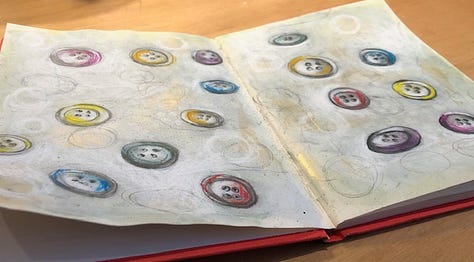

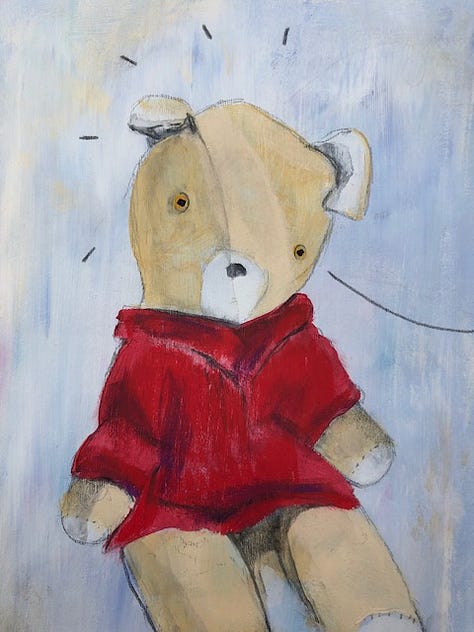
My next ‘Dear Reader, I’m lost’ post will of course be published next Saturday.
Thank you for reading! If you enjoy ‘Dear Reader, I’m lost’, please share and subscribe for free.
Spare room = guest bedroom.
Rachel is my Godmother.
Reader, the only tools you need to turn any café cake into a full-on ‘cakeaway’ are a polythene bag and a plastic clip. You’re welcome!




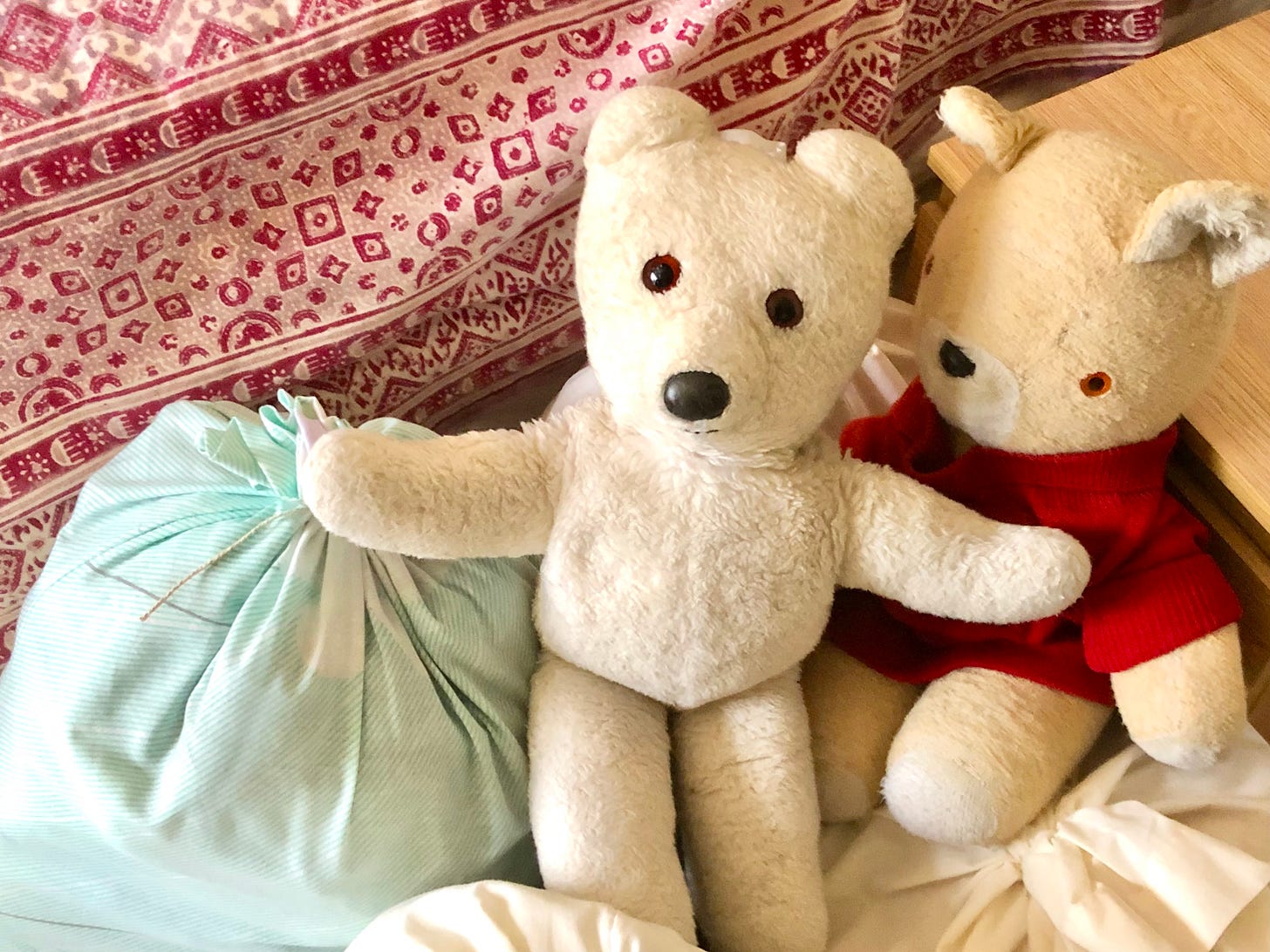
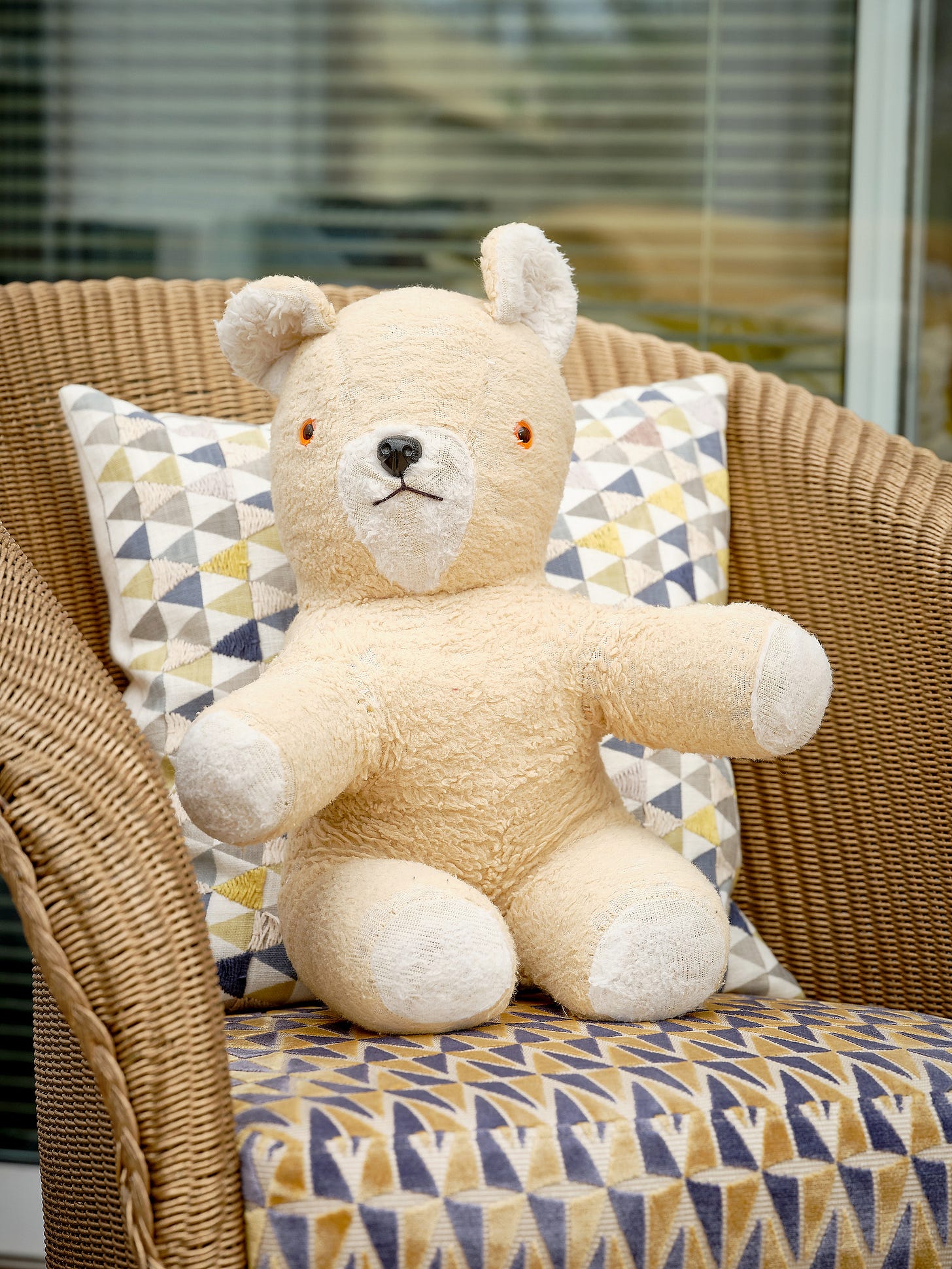
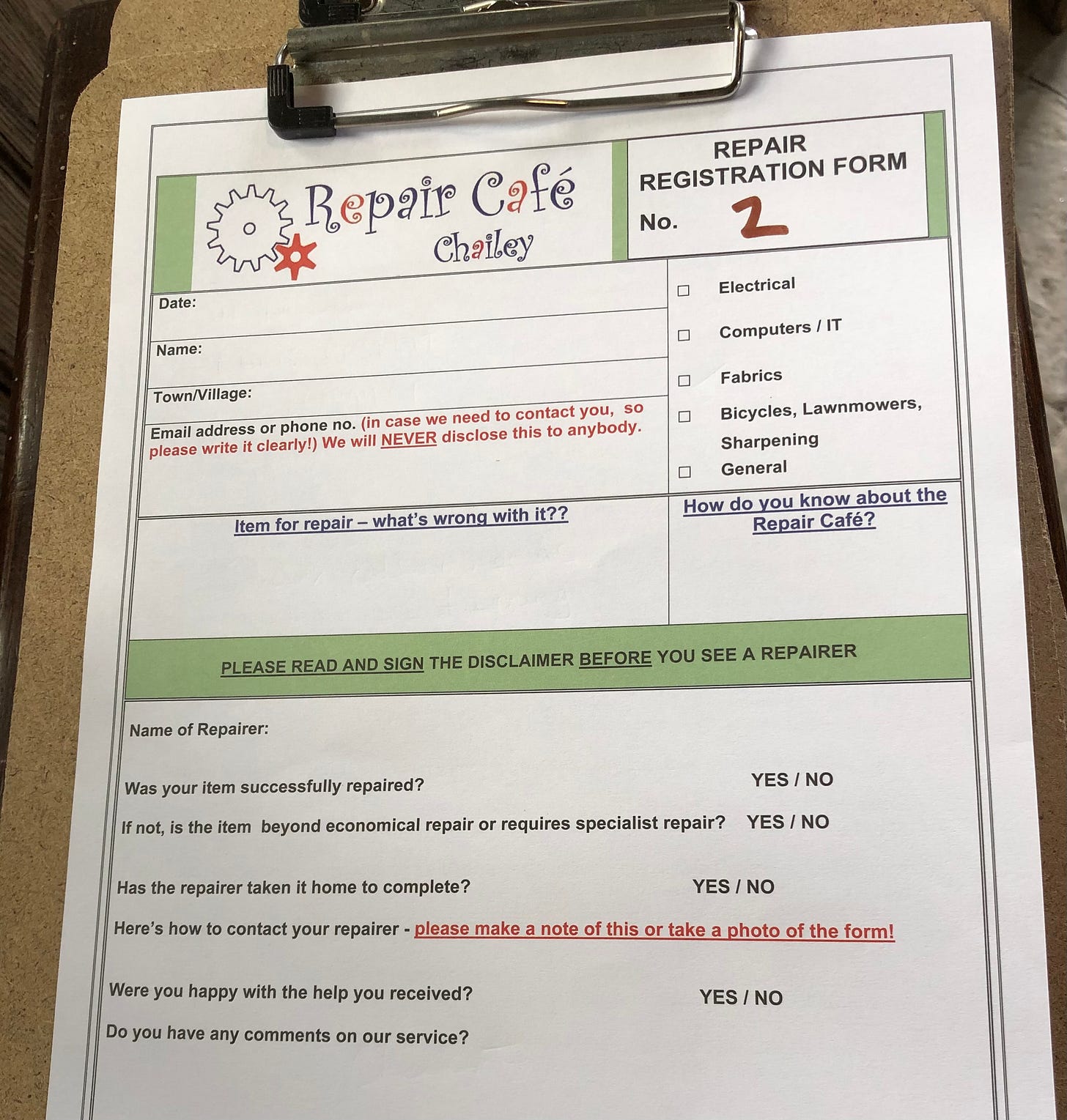

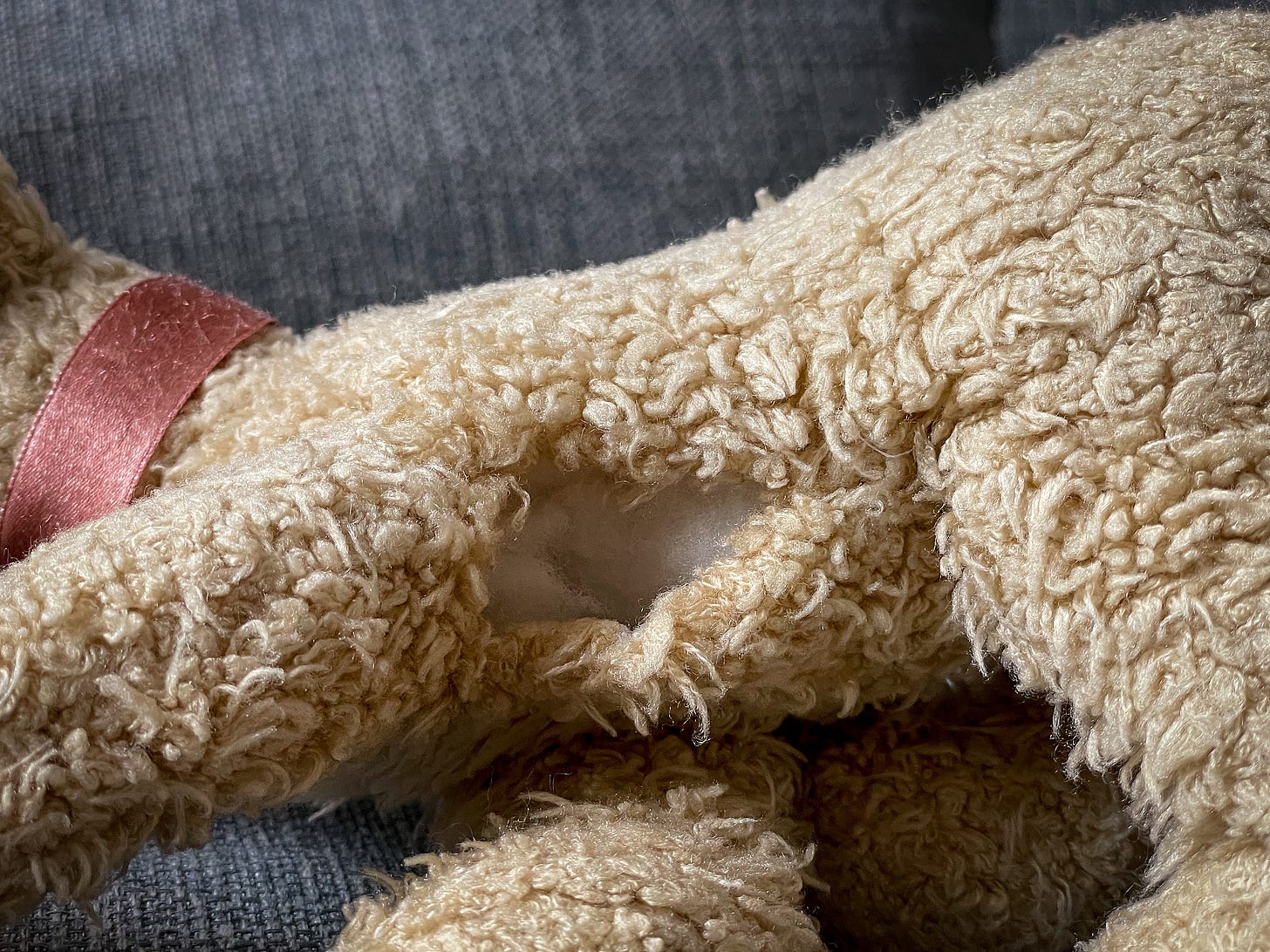
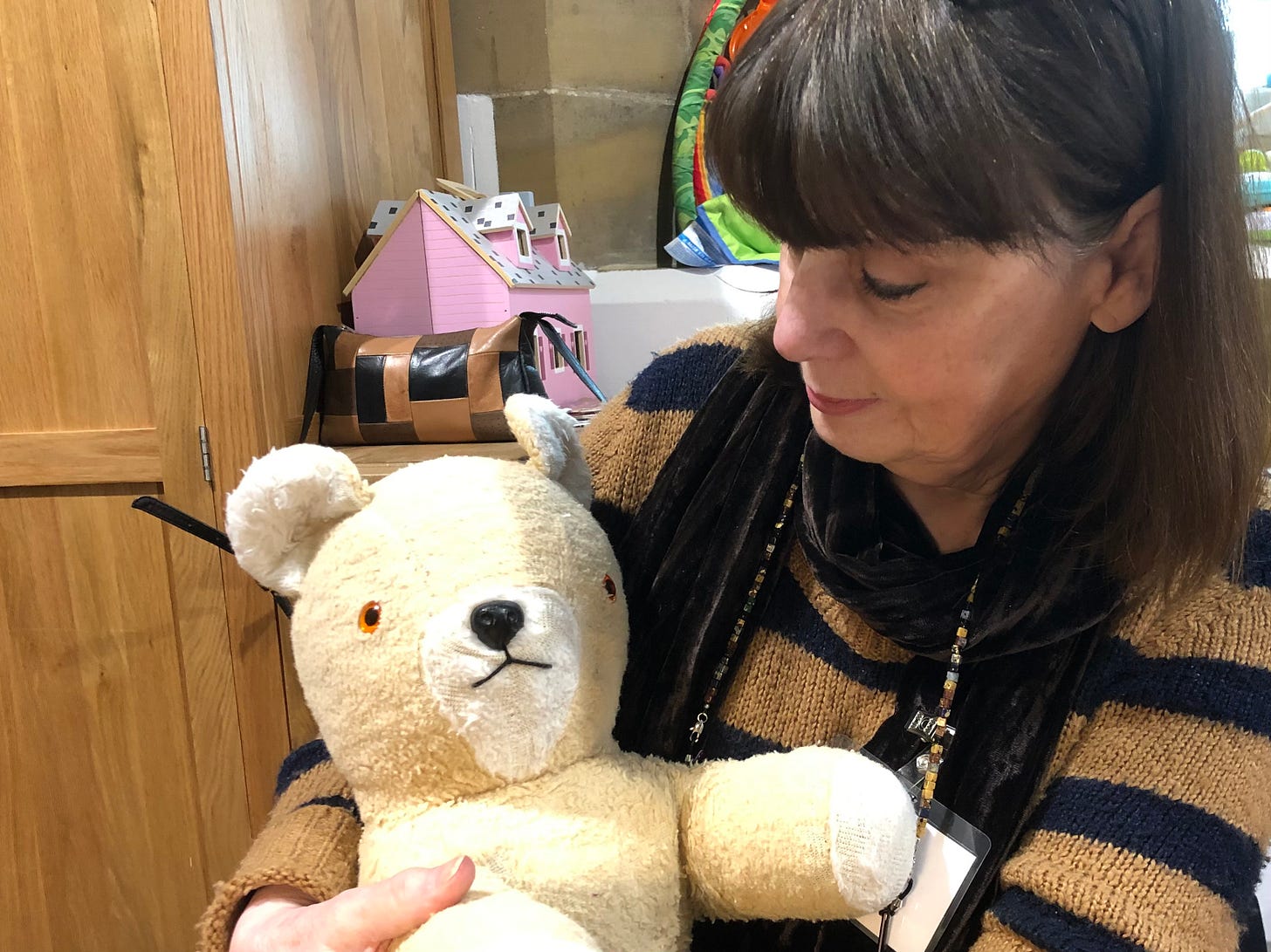
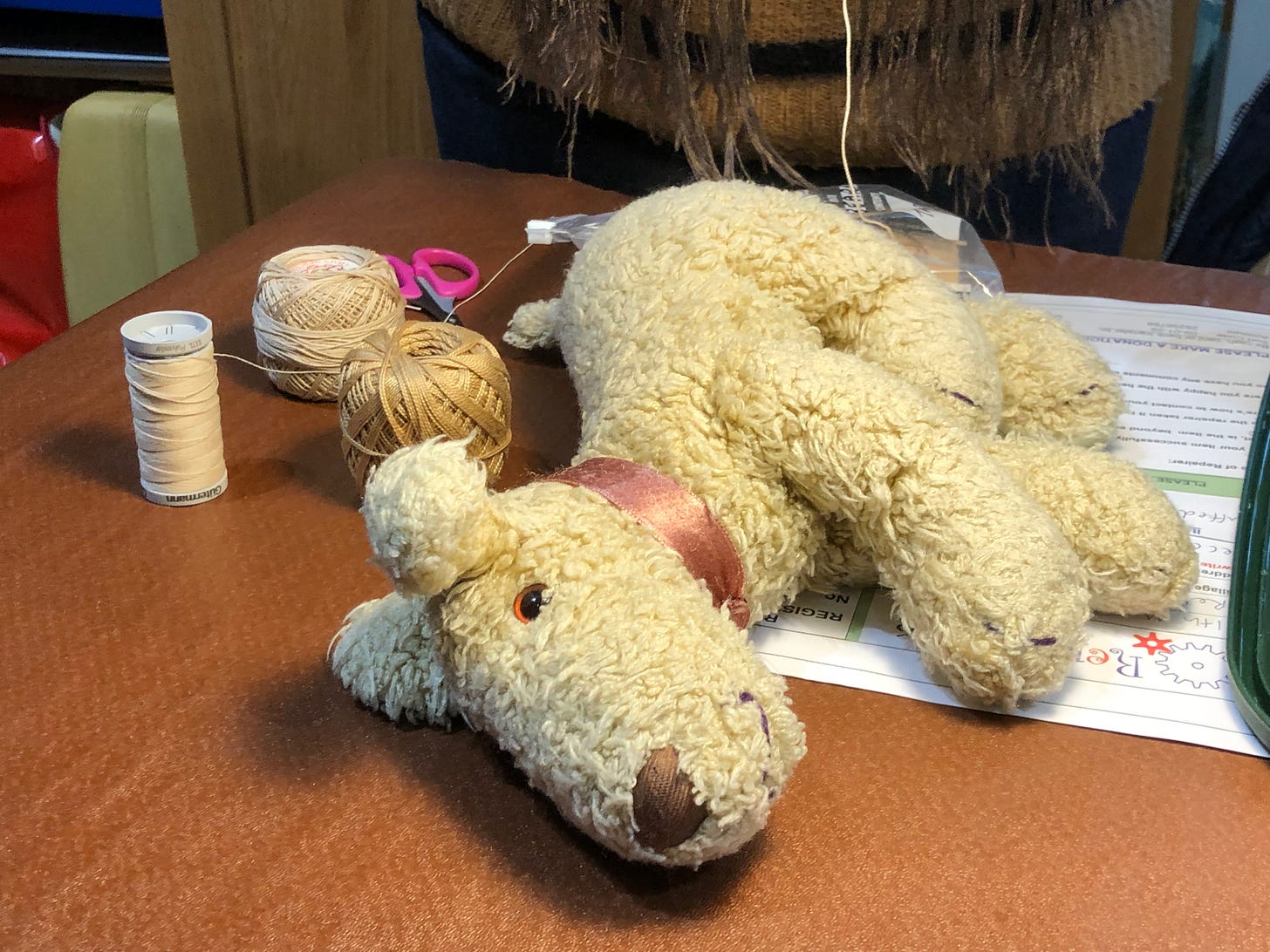
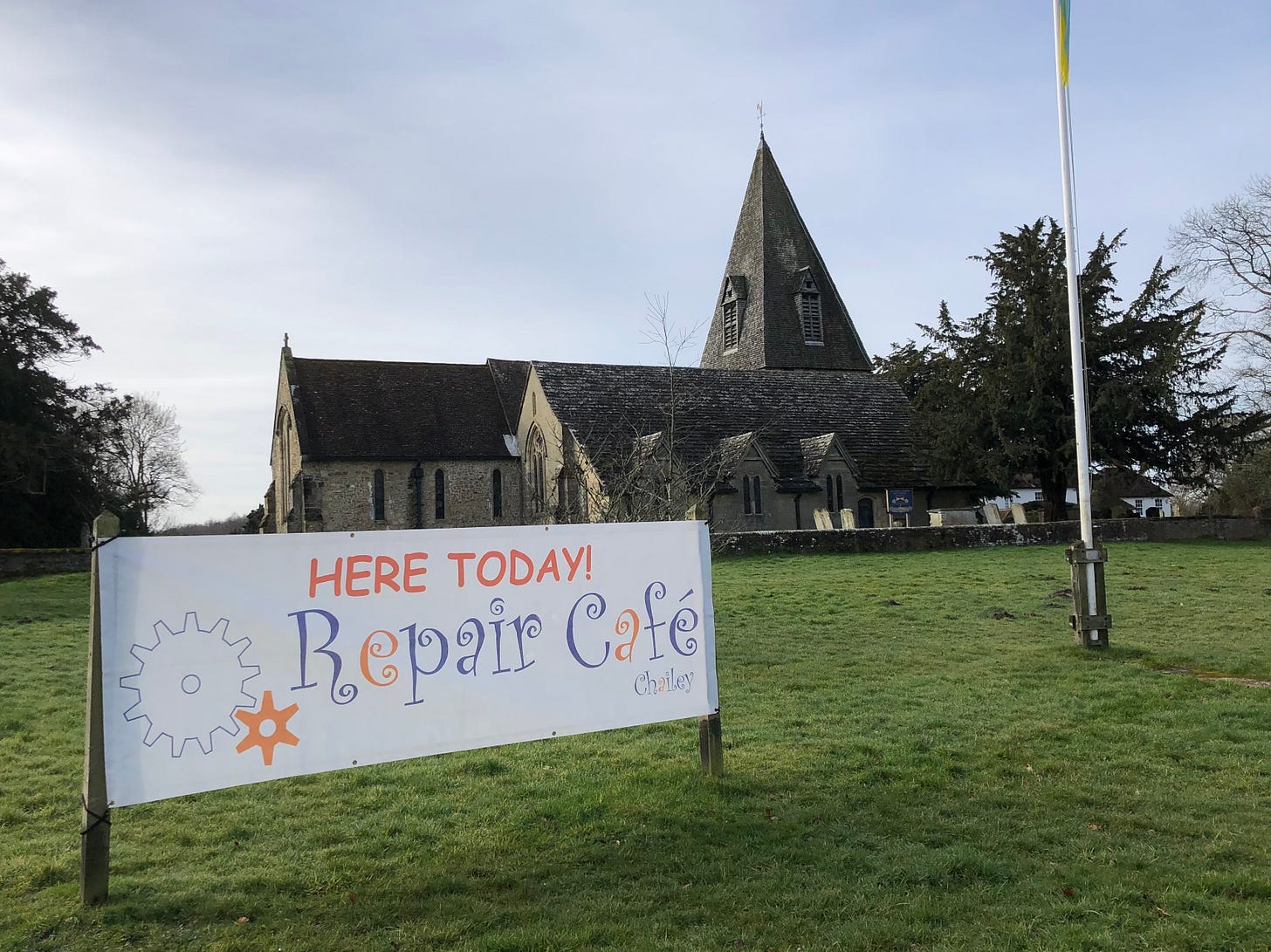
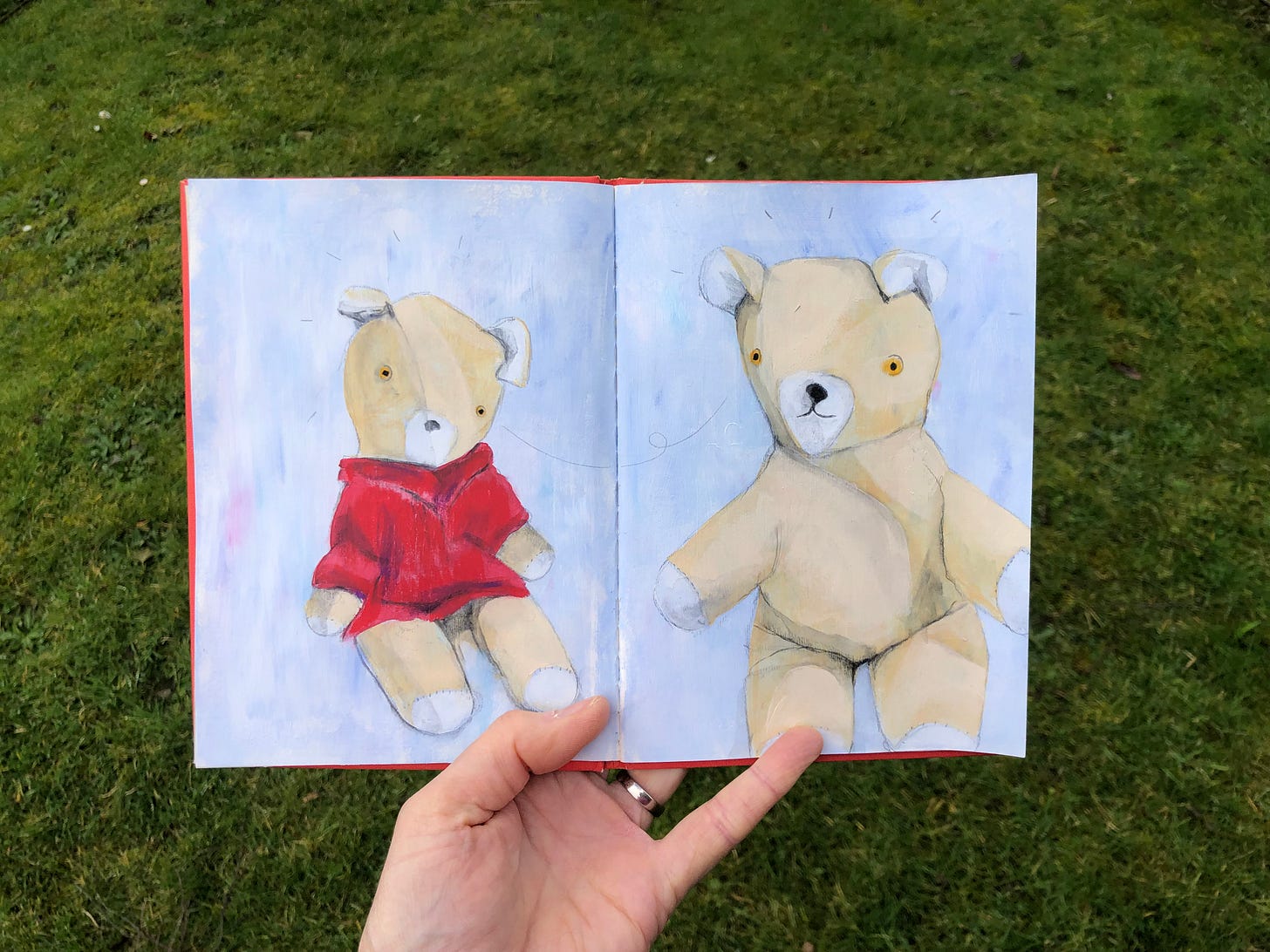
The Repair Café is an international organisation with 2,661 branches across the world run by its amazing volunteers - there might be one near you! Have a look here to see: https://www.repaircafe.org/en/visit/
Love this story and your gorgeous heart-filled drawings! The coworking space I co-founded sponsored a repair cafe every month and also started a ‘library of things’, where people can borrow the items they need when they need them, rather than having to buy it. The two support each other as well, keeping the ‘things’ in circulation as long as possible. And as you mention, it is all built on and by community.
Your bear story makes that clear in such a delightful way.